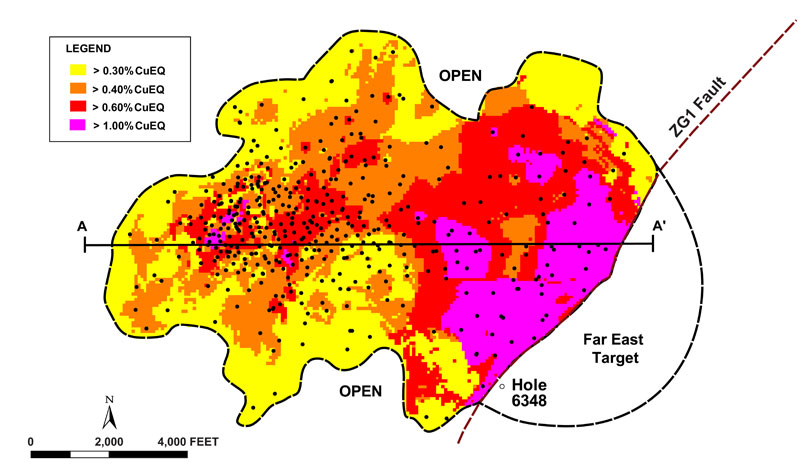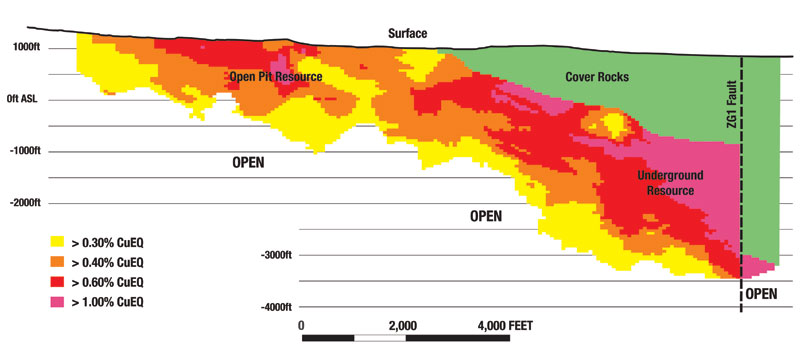Exploration work since 2001 resulted in a significant overall increase in the Pebble deposit, including discovery of the higher grade eastern part of the deposit, and the identification of other copper, gold, molybdenum and silver occurrences along the extensive northeast-trending mineralized system that underlies the property.
Pebble Deposit
The Pebble deposit formed about 90 million years ago when older sedimentary and igneous rocks were intruded by a granitic magma laden with hot fluids carrying dissolved copper, gold, molybdenum, silver and rhenium as well as quantities of palladium. As the fluids cooled, concentrations of sulfide minerals hosting the copper, gold, molybdenum, silver and rhenium metals precipitated in narrow quartz veins and as small grains disseminated throughout the granitic and adjacent sedimentary and igneous rocks. This type of deposit is referred to as a porphyry copper with associated gold, molybdenum and silver.
More than 800,000 feet of the more than 1 million feet drilled at site through 2013 targeted the Pebble Deposit, making it one of the most extensively drilled deposits in the world. The geological controls of the rock type, structure, resource and grade distribution and physical properties of the rocks and the impact of these variables on the metallurgical response of the mineralization are well understood through studies and extensive testing since 2004. These include multiple series of bench-scale flotation tests to better define final recovery grades and equations; a small scale pilot plant; lock-cycle tests to simulate material flows; and comminution tests to assess the grindability of mineralized rock. The results indicate that metallurgical recovery rates at Pebble for copper, gold, molybdenum and silver are at levels expected for such deposits.
Further, this work has expanded the known mineral resources by more than 1,000%, identified significant new areas of high-grade mineralization within the deposit and resulted in a substantial part of the current resource being classified as measured or indicated.
In total, the Pebble resource estimate includes 6.5 billion tonnes in the measured and indicated categories containing 57 billion lb copper, 71 million oz gold, 3.4 billion lb molybdenum, 345 million oz silver and 2.6 million kg of rhenium; and 4.5 billion tonnes in the inferred category, containing 25 billion lb copper, 36 million oz gold, 2.2 billion lb molybdenum, 170 million oz silver and 1.6 million kg of rhenium. Quantities of palladium also occur in the deposit.
The Pebble deposit possesses the volumes, grades, and metallurgical characteristics to support a modern, long-life mine.
There also remains exciting exploration potential to add to the known resource. The deposit is most significantly open to the east, at depth and, possibly, to the south.
Two drill holes are highlighted in the following table: hole 7378 is the most significant intersection within the deposit to date; hole 6348 is outside the current resource but demonstrates the high-grade potential to the east.
|
Hole |
Interval (m) |
Cu% |
Au g/t |
Mo% |
CuEQ% |
|
|---|---|---|---|---|---|---|
|
6348* |
|
289.1 |
1.24 |
0.79 |
0.042 |
1.98 |
|
7378** |
|
261.5 |
1.36 |
1.26 |
0.023 |
2.30 |
|
7378** |
Incl. |
111.6 |
1.78 |
1.15 |
0.033 |
2.70 |
Both holes were drilled vertically.
Prices used for copper equivalent: $1.80/lb Cu; $800/oz Au; $10/lb Mo
*DDH 6348 is NOT included in the current Pebble Resource.
**DDH 7378 is within the current Pebble Resource. The second interval is included within the longer interval
Plan and Cross Section of Pebble Deposit:
Other Exploration Potential on the Pebble Property
The potential to find and delineate satellite deposits elsewhere on the Pebble property is clear, and warrants follow-up drilling in the years ahead. In fact, 10 zones of Cretaceous mineralization, comparable in age to the Pebble deposit have already been discovered in the area. These include several porphyry copper as well as gold and polymetallic vein prospects. For example, at the 38 Porphyry Zone is a significant deposit of Cu-Mo-Au mineralization associated with quartz-sulphide veins and alteration within granodiorite, characterized by intersections of potentially ore grade mineralization over a 17- hole area. In addition, two identified zones of precious-metals bearing, vein-style mineralization of Eocene age occur on the property.




